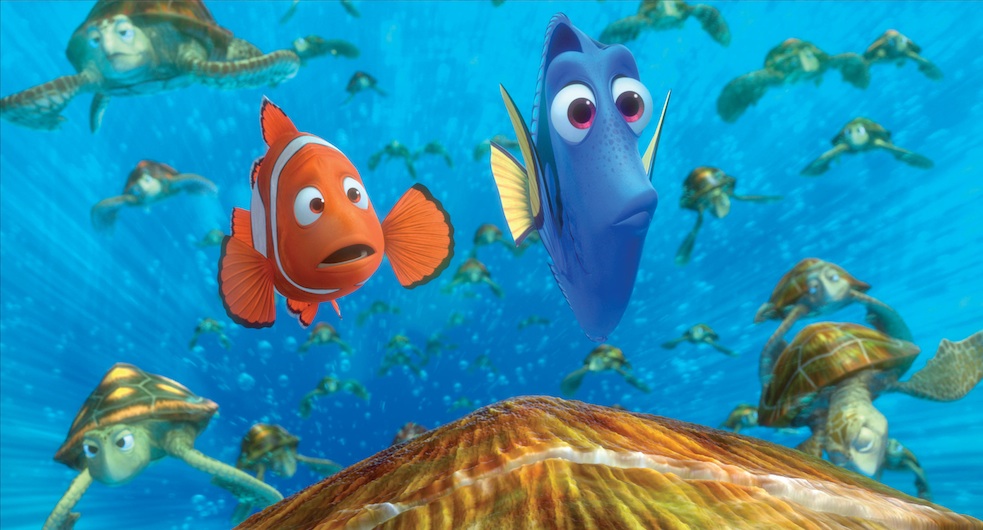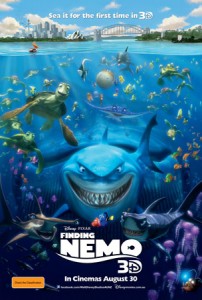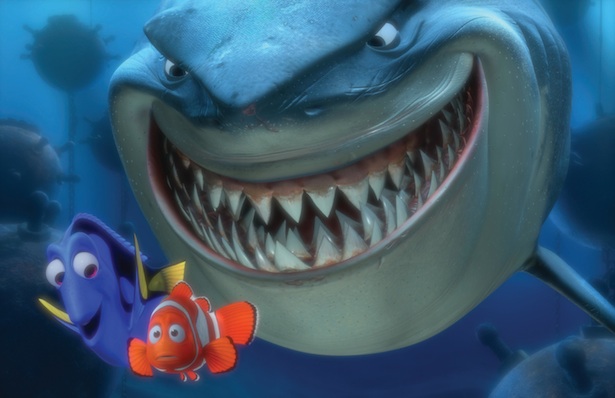Pixar’s classic returns in a whole new dimension, adding depth to the deep blue world so lovingly created by these masters of animation.
[stextbox id=”grey” caption=”Finding Nemo 3D (2003/2012)” float=”true” align=”right” width=”200″]
Director: Andrew Stanton, Lee Unkrich
Writer: Andrew Stanton, Bob Peterson, David Reynolds
Runtime: 100 minutes
Starring: Albert Brooks, Ellen DeGeneres, Alexander Gould, Willem Dafoe, Geoffrey Rush
Distributor: Disney
Country: US
Rating (?): (★★★★★)
When Finding Nemo hit cinemas in 2003, Pixar could do no wrong. Indeed, almost a decade later – with the possible exception of Cars – there has been nary a misstep in the cinematic canon. The winners of no less than three Best Animated Feature Oscars, a number of their recent films (Up and Toy Story 3) have even been nominated for Best Picture of the year by the same Academy. While their debut Toy Story may have been the film that put the then-radical Pixar Studios on the map, and was the impetus for birth of a number of other rival computer-generated animation houses, it is arguable that Finding Nemo was the film that shot them into the stratosphere. Coming only second to The Lord of the Rings: The Return of the King at the box office that year, and remains one of the highest grossing animated features of all time.
When clownfish Marlin (voiced by Albert Brooks) loses his wife and most of his spawn to one of the ocean’s more sinister creatures, he becomes the overprotective father his sole surviving son Nemo (Alexander Gould). After reluctantly letting Nemo attend school, tragedy strikes when Nemo is snatched by a group of human divers. Frantic, Marlin swims out into open waters in search of his boy. Teaming up with forgetful but optimistic blue reef fish Dory (voiced by Ellen DeGeneres), Marlin must face sharks, jellyfish and other ocean dangers in the quest to find Nemo.
Regardless of the increasingly outlandish settings of Pixar’s films, more recently taking us into space and away on a balloon-powered house, the attraction of the films have always been their emotional core. Just as the Toy Story films were about dealing with mortality or outliving one’s usefulness, Finding Nemo deals with the very human issue of dealing with children growing up and knowing when to let go. Marlin may be the quintessential overreacting parent, but whether we are parents or not, we can completely relate to the pain and angst this orange clownfish feels. Pixar have an incredible ability to make audiences cry within the first ten minutes of a film, most notably in Up and Toy Story 3. The opening scenes of Finding Nemo are devastating, but are also fundamental in helping us identify with Marlin’s pain and providing a sense of urgency and immediacy to his quest, which begins not too long after the initial tragedy. Part of the reason Pixar is still spoken of in revered tones is not simply because of the quality of their animation, which is sublime, but because their ability to evoke feeling in everything from fish to robots falling in love is genuine and heartfelt.
Despite nine years having passed since Nemo first went missing, a relative century in animation turns, Finding Nemo is as fresh as the day it was released. It is by no means a major departure from Pixar’s earlier (or subsequent) works, essentially sticking to the same mismatched buddy comedy formula that has worked so well in Toy Story, Monsters Inc., Up, Cars, Ratatouille and to a lesser extent, WALL-E. Once again, this reliance on formula has worked for the studio and there was no reason they should depart from it: they have become very good at showing us a secret world unbeknownst to humans. It also provides much of the accessible comedy for both kids and adults: the little ones may laugh at the sheer ditziness of Ellen’s Dory or surfer dude Crush the turtle, while adults will find much to like about a group of vegetarian sharks (voiced by Australia’s own Barry Humphries, Eric Bana and Bruce Spence). Australians are actually depicted as a functioning nation of adults as well, with genuine Aussie voice Bill Hunter as a dentist and Geoffrey Rush as Nigel the pelican. Non-Australian voices, including Willem Dafoe, give additional weight to the film without overwhelming it with their infamy.
Finding Nemo will long remain one of Pixar’s classics, with a timeless quality that will ensure it finds a new audience every generation. Having been the better part of a decade since the film was released, it is time for a whole new audience to discover the wonders of the magical world beneath the ocean. The 3D for this re-issue may smack of a cheap cash-in on the back of the highly successful The Lion King 3D box office run, but there is nothing sub-par about this release. Adding a whole new layer of depth to the already immersive environment, you’ll want to reach on in and grab hold of some shell, dudes. Finding Nemo just keeps on swimmin’.
Finding Nemo 3D swims back into Australian cinemas on 30 August 2012 from Disney.






